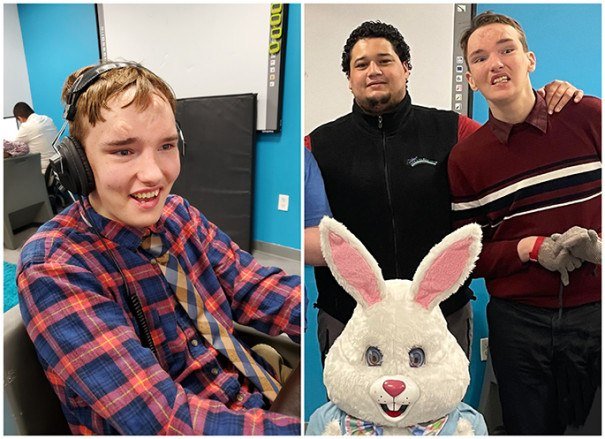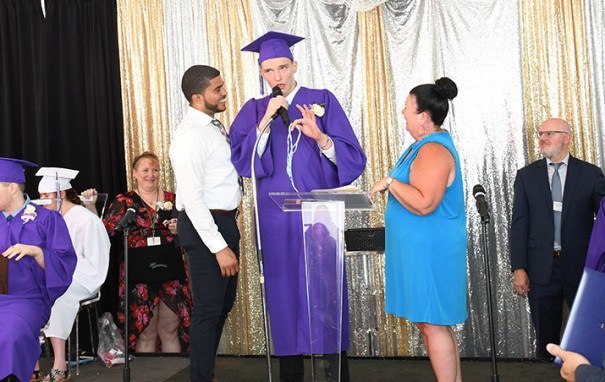Boston-Area School Provides Hope to Parents

By the time his son Chase was in his teens, Rick Simon moved his family from Virginia, to New York and to Massachusetts to find him help. Each new state and each new school was to no avail for the child with autism who routinely tried to harm himself and others and needed to be physically restrained.
“He had been kicked out of every school that he’d been to,” Rick Simon says.
But then, three years ago, he decided to enroll his son at the Judge Rotenberg Educational Center in Canton, Massachusetts, known for its near-zero rejection and expulsion policy, reducing and even eliminating student’s needs for antipsychotic medications, and rewards-based positive reinforcement.
“As time went on, they kept on taking Chase off more and more medications,” Simon says.
“And what I realized is, his behavior was getting better, not worse…They use this system where you earn rewards if you behave, it worked. He’s not on any medications anymore and we’re bringing him to restaurants.”
Founded in 1971, JRC, a day and residential school, serves students ages five through adult with behavioral, emotional, or psychiatric problems, as well as those on the autism spectrum and those with intellectual disabilities. The center employs over 1,000 staffers to care for more than 300 residents housed in over 50 residential homes and apartments in nearby suburban communities of Canton. After graduating from JRC, students have received high school diplomas, learned life skills to live more independently with their parents or guardians, and found work in their communities.
By dedicating its staff and resources to upholding its near-zero rejection and expulsion policy, the center provides hope to parents who fear there is no place that can provide their children with the help they need.

Adapting Education
At JRC, students are enrolled in a year round, five-days-a-week educational setting spread across two buildings which boast the hallmarks of a traditional education, including one-on-one and group learning in classroom settings, a library, physical education in a gymnasium and fitness center, art and music classes, and computers with self-instruction software that allows students to progress through subject matter at their own pace.
To help each student, the center applies Applied Behavioral Analysis. Clinicians and educators analyze how each student’s behavior is affected by their environment to understand how they can decrease that student’s maladaptive or harmful behavior while increasing their communication skills, focus, social skills and academics.
When admitting a new student, the center takes into account the child’s Individualized Education Program, age, grade level and history of behavioral issues, as well as their need for speech, occupational, or physical therapy before placing them on their educational track.
“We’re able to adapt the educational needs to any IEP, including when a student comes in from a different state, different district, or if they have specific goals,” Justin Halton, the center’s director of education, says. “We utilize a behavioral approach to instruction across all subjects, most notably reading and math. A large portion of our student body [need to learn] daily living skills. Our teachers teach these students utilizing an ABA type of philosophy the basics of daily living skills, communication and vocational needs and opportunities.”
Treatments and Rewards
With the help of JRC’s team of clinicians, students navigate their journey towards more independence and a brighter future. After admission, these journeys typically begin with implementing ways to keep a new student and everyone around them safe and, when appropriate, reducing the antipsychotic drugs they are taking. Lynde Kayser, a board certified behavior analyst who applies ABA principles to individually address each student’s needs, has been working with Chase since his arrival at JRC, and remembers a completely different student from the one she knows today.
“Chase engaged in some of the most dangerous and life threatening behavior topographies that I have seen in my career,” Kayser says. “He has been someone who presented significant challenges from the moment that he arrived and for years prior to his arrival … He had to wear a multitude of health related supports, arm splints, a helmet with a full face mask, he’s been required to wear boxing gloves at one point in an attempt to prevent access to his fingers.
“Chase’s progress has been the result of incredible resilience and persistence on the part of both his family and the staff that work with him every day,” she continues. “We’ve seen slow and steady reduction in his problematic behavior to the point that he no longer requires health related support at all for the vast majority of his day. It took a long time to kind of reframe his thinking and his way of approaching the world around him.”
As students like Chase make significant progress, Ms. Kayser said, their adherence to behavioral contracts they sign helps them even further. The center’s positive reinforcement rewards system grants students access to facilities along the center’s yellow brick road, which boasts a sensory room with a ball pit, a movie theater, complete with a popcorn-serving snackbar, an arcade, a hair salon, an internet cafe and even a recording studio. Students can also visit the contract store, where they spend academic money earned for adhering to their contracts and completing academic or vocational activities.

Exploring the World
Just like a traditional educational setting, students at JRC enjoy extracurricular and social activities that offer educational and social growth, such as community outings, a graduation ceremony, parties and dances, including a prom.
After graduating, Chase transitioned into a new adult residence within the JRC system. He works at JRC delivering supplies to various classrooms and activity centers. Perhaps the most significant change to his lifestyle is the newfound closeness he has with his family
“I took him to a Boston Red Sox game last month, 30,000 fans, and he was fine, he was cool,” Rick Simon says. “I couldn’t tell you the last time I saw him hurt himself. We can enjoy our son, we have plans for him, for his future. He can be part of the community. He’s very, very vocal, he expresses his feelings, it’s just amazing.”
“JRC not only saved his life, they saved my life,” he adds. “We feel like now we’re really getting to know him.”
This is a paid partnership between Judge Rotenberg Educational Center and Boston Magazine